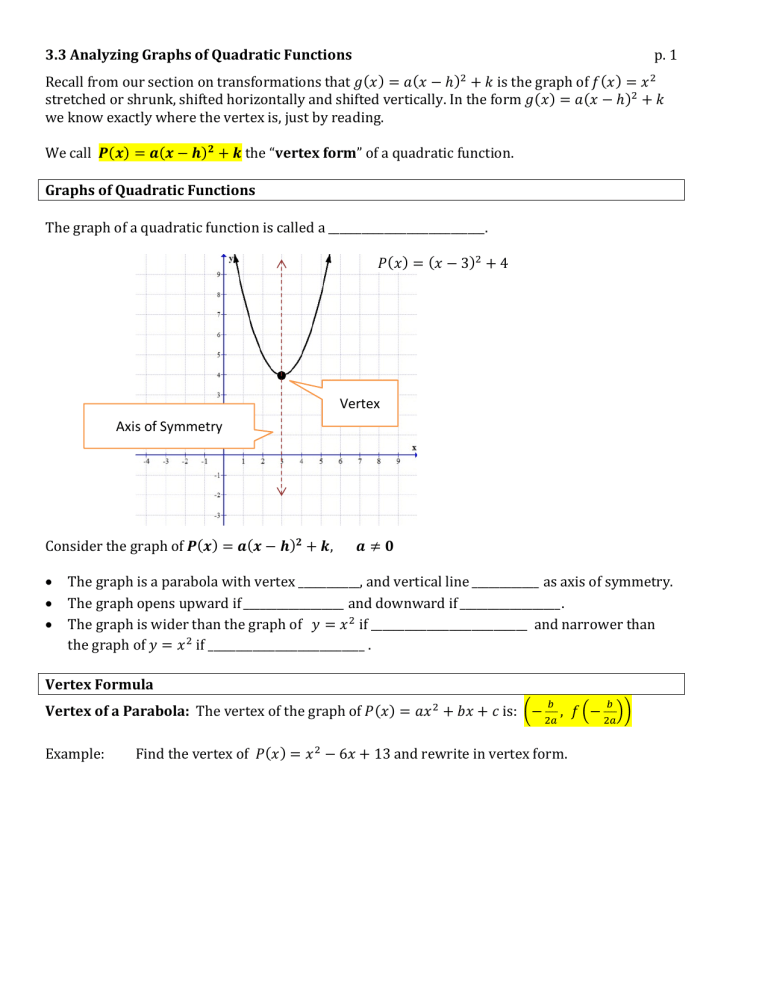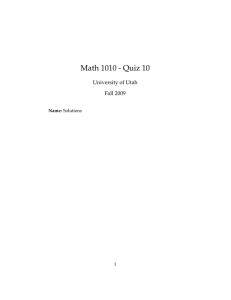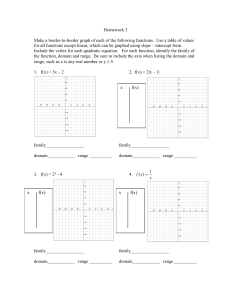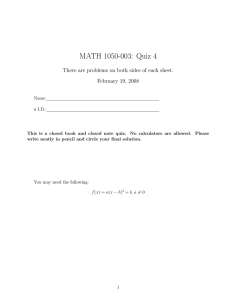
3.3 Analyzing Graphs of Quadratic Functions p. 1 Recall from our section on transformations that 𝑔(𝑥 ) = 𝑎(𝑥 − ℎ)) + 𝑘 is the graph of 𝑓 (𝑥 ) = 𝑥 ) stretched or shrunk, shifted horizontally and shifted vertically. In the form 𝑔(𝑥 ) = 𝑎(𝑥 − ℎ)) + 𝑘 we know exactly where the vertex is, just by reading. We call 𝑷(𝒙) = 𝒂(𝒙 − 𝒉)𝟐 + 𝒌 the “vertex form” of a quadratic function. Graphs of Quadratic Functions The graph of a quadratic function is called a ____________________________. 𝑃(𝑥 ) = (𝑥 − 3)) + 4 Vertex Axis of Symmetry Consider the graph of 𝑷(𝒙) = 𝒂(𝒙 − 𝒉)𝟐 + 𝒌, 𝒂 ≠ 𝟎 • The graph is a parabola with vertex ___________, and vertical line ____________ as axis of symmetry. • The graph opens upward if __________________ and downward if __________________. • The graph is wider than the graph of 𝑦 = 𝑥 ) if ____________________________ and narrower than the graph of 𝑦 = 𝑥 ) if ____________________________ . Vertex Formula > > Vertex of a Parabola: The vertex of the graph of 𝑃 (𝑥) = 𝑎𝑥 ) + 𝑏𝑥 + 𝑐 is: =− )? , 𝑓 @− )?AB Example: Find the vertex of 𝑃(𝑥 ) = 𝑥 ) − 6𝑥 + 13 and rewrite in vertex form. 3.3 Analyzing Graphs of Quadratic Functions p. 2 Extreme Values The vertex of the graph of 𝑃(𝑥 ) = 𝑎𝑥 ) + 𝑏𝑥 + 𝑐 is either the lowest point or the highest point on the graph, depending on the value of a. a) If 𝑎 > 0, then the vertex (ℎ, 𝑘) is called the _________________________ point of the graph. b) If 𝑎 < 0, then the vertex (ℎ, 𝑘) is called the _________________________ point of the graph. Now let’s put all this together… Example 1: For 𝑃(𝑥 ) = −2𝑥 ) + 4𝑥 + 1, find: Vertex ____________________ Vertex form: _____________________________________ Axis of symmetry ____________________ Opens up or down ? ____________________ Is the vertex a maximum or minimum? ___________ Find two other points on the parabola: • First, what is the y-­‐‑intercept? • Because of symmetry, what is another point on the parabola? _______________ The function is increasing on ____________________, decreasing on _____________________. 3.3 Analyzing Graphs of Quadratic Functions p. 3 Applications A ball is thrown upward from a height of 6 feet with an initial velocity of 20 feet per second. The function 𝒔(𝒕) = −𝟏𝟔𝒕𝟐 + 𝟐𝟎𝒕 + 𝟔 gives the height of the ball, in feet, t seconds after it is thrown. a) The baseball reaches its maximum height of ____________feet after ___________seconds. b) How long does it take for the ball to hit the ground, assuming no one catches it? A farmer wishes to construct a rectangular pen using his barn as one side of the pen. He has 160 feet of fencing. What dimensions would produce the maximum area for the pen? What is the maximum area? 3.3 Analyzing Graphs of Quadratic Functions p. 4 The profit of a company, in dollars, is the difference between the company’s revenue and cost. Total profit = Total Revenue – Total Cost 𝑷(𝒙) = 𝑹(𝒙) − 𝑪(𝒙) The cost and revenue functions for a particular company are given below. The x represents the number of items produced and sold to its distributors. 𝑪(𝒙) = 𝟐𝟒𝟎𝟎 + 𝟒𝟎𝒙 𝑹(𝒙) = 𝟕𝟖𝟎𝒙 − 𝒙𝟐 a) Write the total profit function for this company. b) What is the profit if 100 units are produced and sold? c) The number of items that must be sold to obtain the maximum profit is ________ d) The maximum profit of the company is ________






